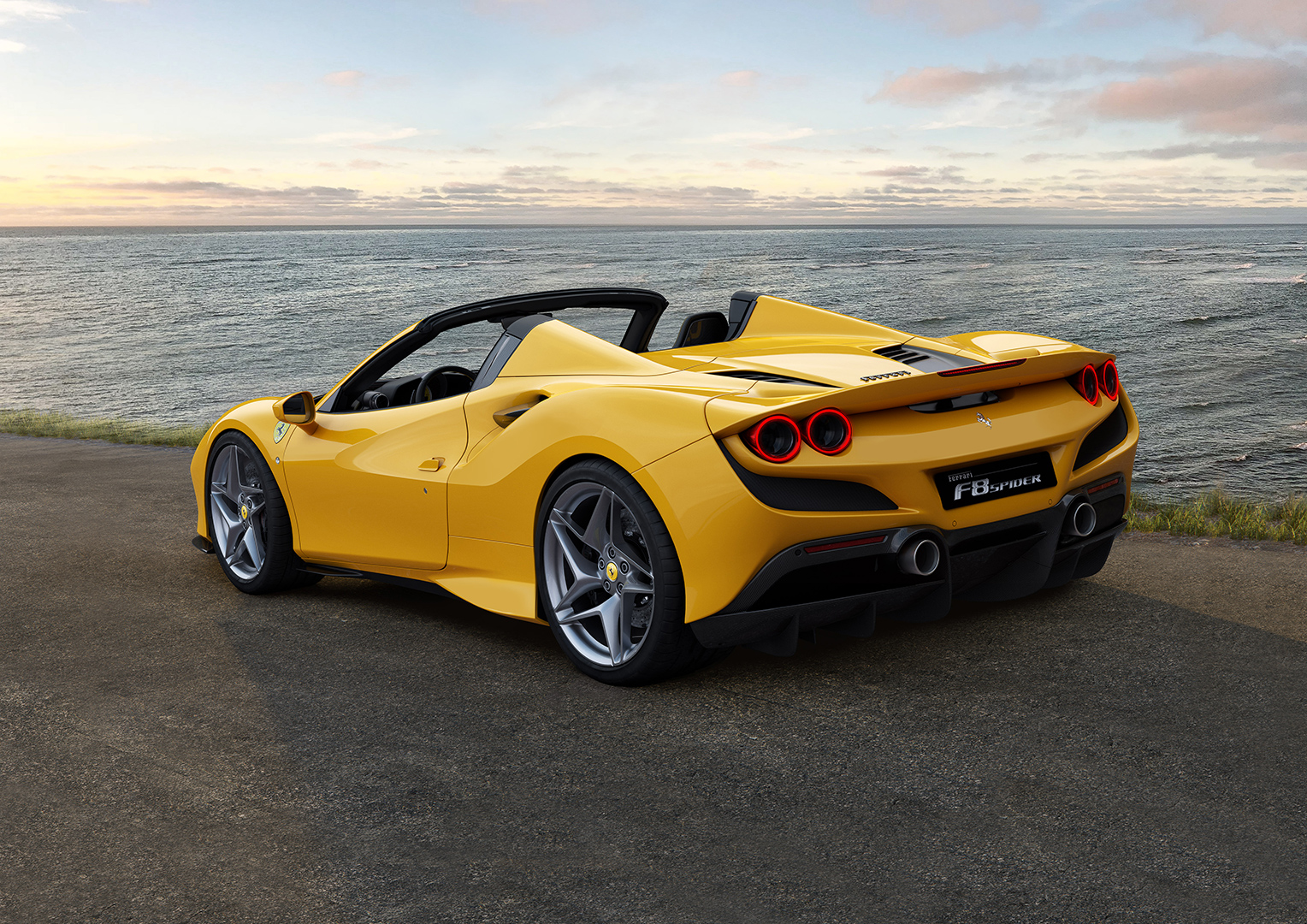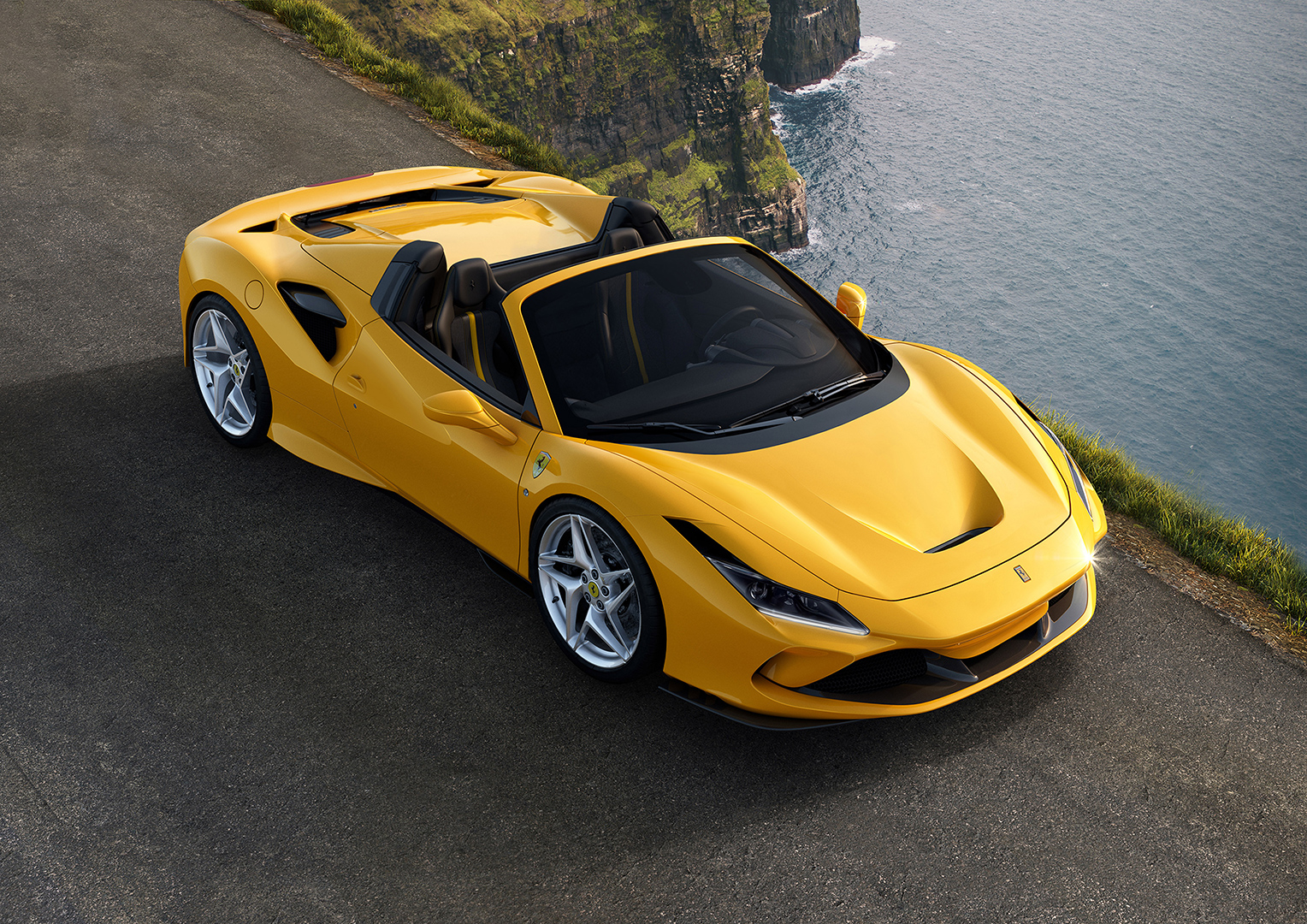Wild at heart

Ferrari F8 Spider
the evolution of the species
- CO2 Emission:
- Low: 475 g/km
- Mid: 282 g/km
- High: 250 g/km
- Extra High: 277 g/km
- Combined: 296 g/km
- Fuel consumption:
- Low: 20,9 l/100km
- Mid: 12,4 l/100km
- High: 11,0 l/100km
- Extra High: 12,2 l/100km
- Combined: 13,0 l/100km
The values of fuel consumptions and CO2 emissions shown were determined according to the European Regulation (EC) 715/2007 in the version applicable at the time of type approval.
The fuel consumption and CO2 emission figures refer to the WLTP cycle.
In order to be placed on the market, passenger cars carry out a series of tests to verify their compliance with regulations.

The tests to assess fuel consumption, CO2 and pollutant emissions are carried out in the laboratory and are based on specific driving cycles. In this way, the tests are reproducible and the results comparable. This is important because only a laboratory test, which follows a standardized and repeatable procedure, allows consumers to compare different car models. On 1 September 2017, the new Worldwide harmonised Light-duty vehicle Test Procedure (WLTP) came into force in Europe and will gradually replace the New European Driving Cycle (NEDC) protocol. NEDC (New European Driving Cycle): it has been the European driving cycle used so far for the measurement of fuel consumption and emissions from passenger cars and light commercial vehicles. The first European driving cycle came into force in 1970 and referred to an urban route. In 1992 it was also considered to have an extra-urban phase and since 1997 it has been used for measuring consumption and CO2 emissions. However, the composition of this cycle is no longer consistent with current driving styles and distances travelled on different types of roads. The average speed of the NEDC is only 34 km/h,
accelerations are low and the maximum speed is just 120 km/h. WLTP procedure: WLTP uses new Worldwide harmonised Light-duty vehicle Test Cycles (WLTC) to measure fuel consumption, CO2 and pollutant emissions from passenger cars and light commercial vehicles. The new protocol aims to provide customers with more realistic data, better reflecting the daily use of the vehicle. The new WLTP procedure is characterized by a more dynamic driving profile with more significant acceleration. The maximum speed increases from 120 to 131.3 km/ h, the average speed is 46.5 km/h and the total cycle time is 30 minutes, 10 minutes more than the previous NEDC. The distance travelled doubles from 11 to 23.25 kilometers. The WLTP test consists of four parts depending on the maximum speed: Low (up to 56.5 km/h), Medium (up to 76.6 km/h), High (up to 97.4 km/h), Extra-high (up to 131.3 km/h). These parts of the cycle simulate urban and suburban driving and driving on extra-urban roads and motorways. The procedure also takes into account all vehicle’s optional contents that affect aerodynamics, rolling resistance and vehicle mass, resulting in a CO2 value that reflects the characteristics of the single vehicle.

The WLTP procedure will gradually replace the NEDC procedure. The WLTP applies to new passenger car models from 1 September 2017, to all passenger cars registered from 1 September 2018 and is mandatory for all EU Member States. Until the end of 2020, both fuel consumption and CO2 emission values in WLTP and NEDC will be present in the vehicle documents. Indeed, NEDC values will be used to assess the average CO2 emissions of cars registered in the EU throughout 2020. In addition, some countries may continue to use the NEDC data for fiscal purposes. From 2021 onwards, WLTP data will be the only consumption/ CO2 emissions values for all cars. Used vehicles will not be affected by this step and will maintain their certified NEDC values.
ROAD CONSUMPTION AND EMISSIONS OF PASSENGER CARS
The new WLTP test procedure is more representative of current driving conditions than the NEDC procedure, but it cannot take into account all
possible cases including the effect of the driving style that is specific to each individual driver.
Therefore, there will still be a difference between emissions and consumption measured in the laboratory and those resulting from the use of the vehicle in the real world, and the extent of this difference will depend on factors such as driving behavior, the use of on-board systems (e. g. air conditioning), traffic and weather conditions that are characteristic of each geographical area and each driver. For this reason, only a standardized laboratory test allows to obtain values with which it is possible to compare vehicles and different models in a fair way.
WHAT CHANGES FOR CUSTOMERS
The new WLTP procedure will provide a more realistic criterion for comparing the fuel consumption and CO2 emission values of different vehicle models as it has been designed to better reflect real driving behavior and take into account the specific technical characteristics of the individual model and version, including optional equipment.

THE BEST ENGINE IN THE LAST 20 YEARS
- V8 TurboEngine
- 720cvMaximum power
- V8ENGINE
- 2,9 s0-62 mph
- 1,94 kg/CVSpecific Output
- 530 kWMaximum power
The
F8 Spider’s greatest achievement is the fact that it unleashes its
power instantaneously with zero turbo lag, whilst retaining this V8’s
unique and very special soundtrack.
ELEGANT, POWERFUL, MADE TO BE ENJOYED



The
F8 Spider has taken state-of-the-art aerodynamic solutions and
innovations from Ferrari’s GT and Challenge racing experience, and
moulded them into the production mid-rear-engined
drop-top that makes the highest level of performance accessible to
drivers of all abilities.

In
the F8 Spider, the position of the front radiators - which, unlike the
488 Spider, are rearward-angled - is beneficial in cooling terms but
simultaneously shrinks the underbody surface
area that can be used to generate downforce. Thus the geometry of the
channels used to dissipate hot air had to be redesigned to ensure that
maximum downforce was generated whilst cutting drag thanks to the
positive interaction between the flows exiting the
radiator and the front wheels. The result is a 10% improvement in the
car’s overall efficiency compared to the 488 Spider.


SIMPLICITY IS THE ULTIMATE SOPHISTICATION
To achieve
their goal of making the car’s impressive performance easy to access
and control, Ferrari’s engineers worked on integrating engine and
aerodynamics performance with the latest
iteration of the vehicle dynamics control systems.
Overall performance levels are significantly higher than those of the 488 Spider, thanks to the increase in power, weight reduction and improved aerodynamic coefficient.
That performance is also now accessible to a larger number of drivers thanks to vehicle dynamics systems that make driving on the limit an easier and more confidence-inspiring experience. These include a steering wheel with a smaller-diameter rim and the introduction of the new Ferrari Dynamic Enhancer Plus into the integrated SSC concept, now in 6.1 guise.

The FDE is a lateral dynamics control system that uses Ferrari software to adjust the brake pressure at the callipers. It debuted on the 488 Pista and was later adopted on the 488 Pista Spider. The F8 Tributo then featured the new FDE+ version with extended functionality which is now also being used on the F8 Spider. The control system, which is operational through and exiting corners (but not under braking), now also extends to low grip conditions and to the Race setting of the manettino.


DESIGNED BY THE WIND
Designed by the Ferrari Styling Centre, the F8 Spider continues the direction embarked upon with the F8 Tributo which acted as a bridge to a new design language that will continue to emphasise Ferrari’s key characteristics of high performance and extreme aerodynamic efficiency.
When designing a spider, the choice of the top will always play a fundamental role in the car’s overall look. For some years now, Ferrari has been adopting a hard top because of the comfort it provides. As a result, the design of the F8 Spider’s lines was crafted around its RHT (Retractable Hard Top).
The key to the whole design was the shifting of the separation line between the car’s body and the roof from its conventional position at the belt-line (occupant shoulder level) to above the B-pillar. The top itself is thus more compact and two-dimensional, with the result that it can be divided into two parts and stowed on top of the engine.
The RHT takes just 14 seconds to deploy or retract and can be closed or opened while the car is on the move up to 45 km/h.
The goal the Ferrari Styling Centre set itself with the F8 Spider was to design a stylistic tribute to the Ferrari V8 engine, by evolving the contents of the F8 Tributo and taking inspiration from the most iconic mid-rear-engined V8 sports cars in Ferrari history. The result is a car with a strong personality of its own through an even sportier design clearly inspired by the car’s advanced aerodynamics.


PERFECT MATCH
The F8
Spider’s cockpit retains the classic, driver-oriented look typical of
Ferrari’s mid-rear-engined berlinettas. A concept that creates a
symbiotic relationship between driver and
car
SPECIFICATIONS
Partners
- APPLE
- APTIV
- BOSCH
- BREMBO
- CBS
- DTS
- FAURECIA
- FONTANA GROUP
- IHI
- IMR
- LEAR
- MAGNA TS
- MAHLE
- MARELLI
- MICHELIN
- NOVATION
- OMR
- PIRELLI
- SABELT
- SHELL
- SOLVAY
- SPARCO
- STR
- ZF
- Engine
- Aerodynamics
- dynamics
- Design
- Interior
- Technical details
- Media Gallery


